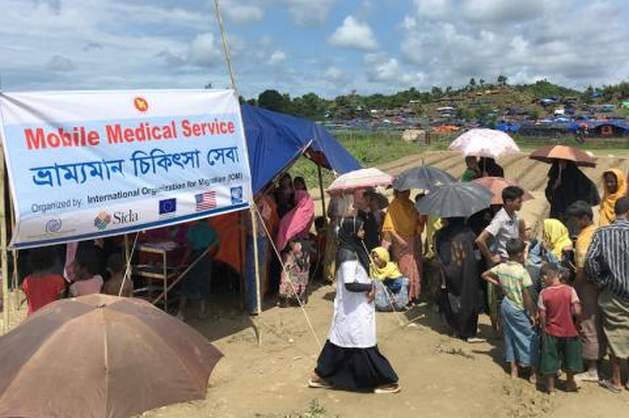Thursday, April 25, 2024
News and Views from the Global South
Cox’s Bazar Health Facilities Struggle to Cope as New Arrivals Pass 415,000: IOM Scales Up Mobile Teams, Support to Government Clinics

People line up outside an IOM mobile clinic in Unchiprang spontaneous settlement. Photo: UN Migration Agency (IOM) 2017
- IOM, the UN Migration Agency is working with Government and aid agency partners to rapidly ramp up fixed and mobile health services in Bangladesh’s Cox’s Bazar district to help some 415,000 people who have fled violence in Myanmar’s North Rakhine State over the past three weeks.
Many of the new arrivals, who have walked for days through jungle in intense heat and monsoon rains, are already sick and malnourished by the time they reach the teeming settlements of Cox’s Bazar, Bangladesh. Camping in the open with little or no shelter on muddy hillsides with no access to clean water or latrines, the very young and the old are at greatest risk from water borne and contagious diseases.
“Newly arrived children are at high risk of vaccine preventable diseases. Bangladesh is already free of polio and almost free of measles and rubella. So, the Government, the World Health Organization and humanitarian partners launched an urgent immunization programme on Saturday to vaccinate 150,000 newly arrived children. Nutrition support and management of malnutrition, especially severe acute malnutrition, is also urgently needed for these children,” said Dr. Samir Kumar Howlader, IOM National Health Programme Officer.
“Lack of safe drinking water, personal hygiene and sanitation facilities has already resulted in acute watery diarrhea and other water borne diseases. So, disease surveillance and early warning systems also need to be strengthened significantly,” he added.
Others have arrived in Bangladesh with injuries inflicted in Myanmar. “I was living with a gunshot wound for five days. I would have lost my leg if I didn’t get treatment,” said Anayet Ullah, 18, who was in a critical condition when he was treated by an IOM medical team at Ukhiya government health complex. The doctors referred him to Cox’s Bazar Sadar Hospital, where he recovered.
The Ukhiya doctors and nurses are one of 12 IOM teams operating from government health facilities in the two Cox’s Bazar sub-districts of Ukhiya and Teknaf, where the Rohingya population outside the two UNHCR-run refugee camps now totals an estimated 600,000 people, two thirds of whom have arrived since August 25th. Three IOM mobile medical teams have also started providing basic and primary healthcare services in three spontaneous settlements in the area.
In addition to primary health care and referrals, the teams focus on sexual and reproductive health, and maternal and child health. They also provide mental health and psychosocial services to about 120 people each day. They say that all of these services will need to be massively expanded to cope with the influx of new arrivals.
Agencies working in the health sector have told the Inter Sector Coordination Group (ISCG) in Cox’s Bazar that they have already provided treatment to some 52,000 of the new arrivals. But existing facilities are reporting a 150-200 per cent increase in patients, overwhelming current capacity and resources.
They say that an estimated 171,800 newly arrived people are not yet covered by any primary health care services. Primary health care coverage also needs to be expanded as soon as possible to cover all newly arrived populations in both spontaneous and existing makeshift settlements, they note.
The agencies also say that an estimated 14,000 pregnant women are in need of maternal and child health care. An estimated 50 per cent of them are considered to have complicated pregnancies and may need emergency obstetric and neonatal care.
In addition to the immunization campaign, the Ministry of Health, which is leading the health sector response with the support of IOM, says that 16 mobile medical teams and satellite clinics have been mobilized in existing and new settlements, covering an estimated 217,206 new arrivals. They include mobile reproductive health clinics. Three more mobile teams are also providing daily services in no man’s land on the border and eight ambulances are operating. The MoH has also established a Control Room at the Civil Surgeon’s Office in Cox’s Bazar to support coordination of the response.
Last week, IOM has appealed for USD 26.1 million to meet the immediate needs of the 400,000 newly arrived people now sheltering in Cox’s Bazar. The Flash Appeal, covering the next three months, includes USD 3 million for healthcare. The IOM appeal is part of a broader appeal (ISCG Preliminary Response Plan) by all ISCG agencies operating in Cox’s Bazar for USD 77.1 million through year end.
For more information, please contact:
Peppi Siddiq in IOM Dhaka, Tel: +8801755568894, Email: pksiddiq@iom.int
Chris Lom in Cox’s Bazar, Tel. +8801733335221, Email: clom@iom.int

 Print
Print



